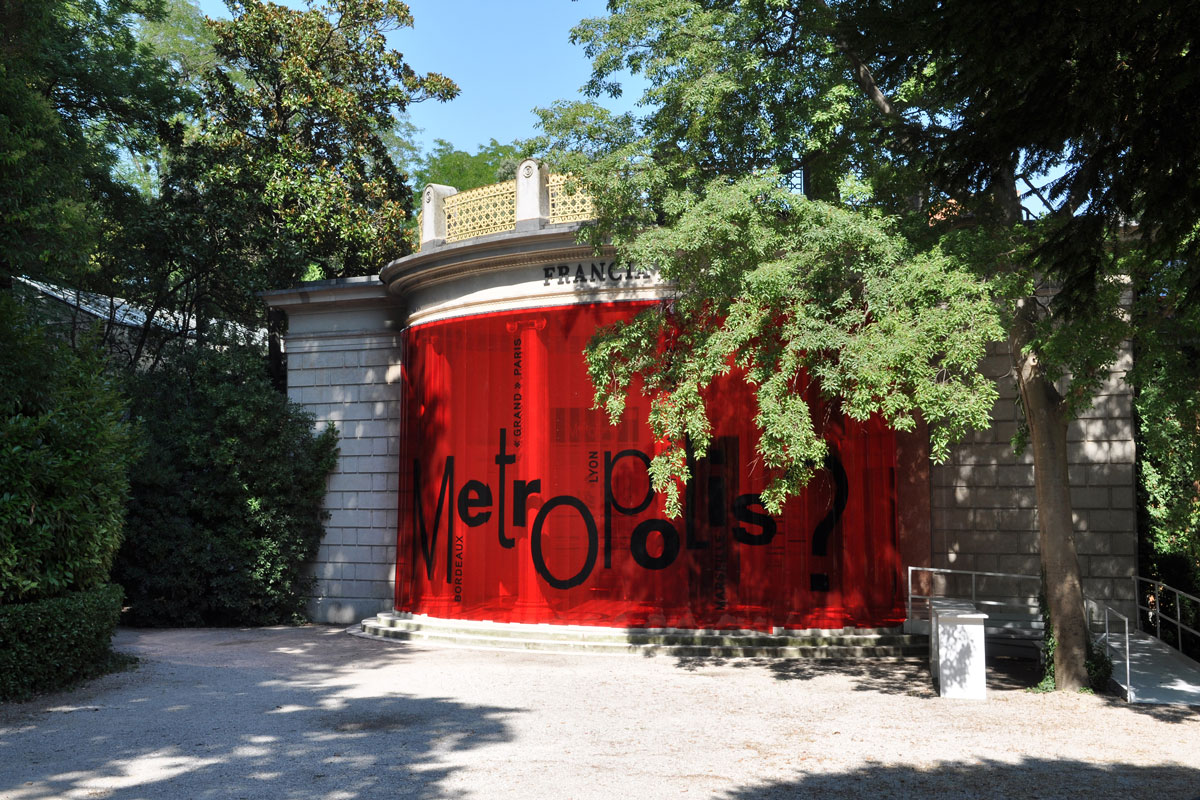The metropolis, in contrast to the
city considered as a single physical mass, is precisely what the city has
rejected, expelled outside of and beyond itself. With the “METROPOLIS ?”
exhibition architect and urbanist Dominique Perrault, chief curator and
producer of the French Pavilion, explores this concept of VOID envisaged as a
material for protecting, restructuring and building the metropolis.
Out of the dialectic between the
solid and the void an alternation emerges, less decisive than it appears, given
how obviously voids unite as much as they separate. The aim and the ambition of
“METROPOLIS ?” are to take up the challenge of that which ties together and no
longer that which unties; to change the economic, social and emotional
understanding of the void in a seizing, a positive, prospective and jubilatory
perception and appropriation; to demonstrate that the void is indeed the most “lived
in space” and to propose a reading that founds, articulates and nourishes the
genesis of the metropolis of the 21st century.
To illustrate his ideas, Dominique Perrault
has invited five major actors on the French scene: the metropolises of Bordeaux,
Lyon, Marseille, and Nantes, as well as the Atelier International du Grand
Paris.
Five experiments, five ways of
linking solids and voids, five proposals for a definition of the metropolis no
longer conceived of as a physical mass but rather as a territory.
Five examples, treated through films
and projected texts, designed in a highly cinematographic way, a sort of installation
in which the screens and mirrors, in an unceasing dialog, create a striking
multiplying effect of images, enhanced by background sounds comprised of
metropolitan noises.
The theme of the French Pavilion
will strive to show that The Metropolis is not a city but a rather a territory comprised
essentially of open and available spaces. The revelation, transformation and
protection of these VOIDS are the various strategies, projects or actions that
our cities offer to those who govern, imagine and live in them.
Consequently, it is the perception
of these voids as the places open to all possibilities which guides the
approach to the subject and the exhibition design of the French Pavilion. The experience
is a sensorial one, immersing the visitor in the substance of the metropolis.
The walls are covered from the floor to ceiling with film projections. These
images reflect each other through the skillful use of mirrors, dematerializing
the immobile architecture of the edifice.
This matter in movement relies on three
media: film, with images of the reality on the ground, shot across the five territories;
visuals of metropolitan projects and a series of maps designed to highlight the
nature of the void both in the metropolis and the national territory.
The French Pavilion is transformed
into a multiplex cinema with a permanent program featuring three sequences at
regular intervals.
1. METROPOLIS ? Sequence
The film METROPOLIS ?, screened at center
of the pavilion, was specifically made for this Biennale by Dominique Perrault
with cineaste and documentarist Richard Copans and Cyrille Poy, editor-in-chief
of L’Architecture d’Aujourd’hui.
It seeks to reveal the breadth of
the void’s presence, in order to grasp the full scope of the new territories
these five French metropolises offer. This physical dimension of the void appears
as a collective good that constitutes the wealth and the future of «Grand»
Paris, “Grand” Bordeaux,
“Grand” Lyon, “Grand” Nantes and “Grand”
Marseille.
Echoing the subject of the film METROPOLIS
?, the films projected in the side rooms are dedicated to the presentation of
emblematic and specific projects of the invited metropolises. Bordeaux, Lyon,
Nantes and Marseille lay out their strategies, the places and the forms of
their urban projects that are transforming their city into a metropolis, i.e.,
that are constructing it.
This cinematographic arrangement aims
to set up a dialectic exchange between the films that visualizes the
construction of the metropolis: THE SOLID, and the one revealing the nature of
the metropolitan territory: THE VOID.
2. PARIS «Grand Paris » Sequence
A film on the international
consultation held for «Grand Paris» and presenting the themes and strategies of
the ten participating design teams is projected at the center of the Pavilion.
In the side galleries, bird’s-eye
views of the three concentric ring roads that encircle the capital—the “Périphérique”
or inner ring road and the two outer rings of the A86 and the “Francilienne”— complement
this focus, their understanding further enhanced with maps tracing the evolution
of the territory from Paris to «Grand Paris».
3. “Bonus” Sequence
Every hour, the walls of the
Pavilion are covered by two “Bonuses.” These sequences broaden the scope of the
metropolitan question to the international and global level: towards a Global METROPOLIS
?
With over 20 different films, the
French Pavilion will attempt to focus on this emerging urban condition rooted in
a vast territory and shown here for the first time from the perspective of the
contemporary form of the city: METROPOLIS.
However, the visitor will never be
able to see everything. The very nature of the metropolis escapes any notion of
total perception.
Beyond the Pavilion, the discussion continues in a special edition of the journal L'Architecture d'Aujourd'hui, with Dominique Perrault as guest editor.
"Metropolis?”
French Pavilion of the 12th
Venice Architecture Biennale
August 29th – November 21st,
2010

